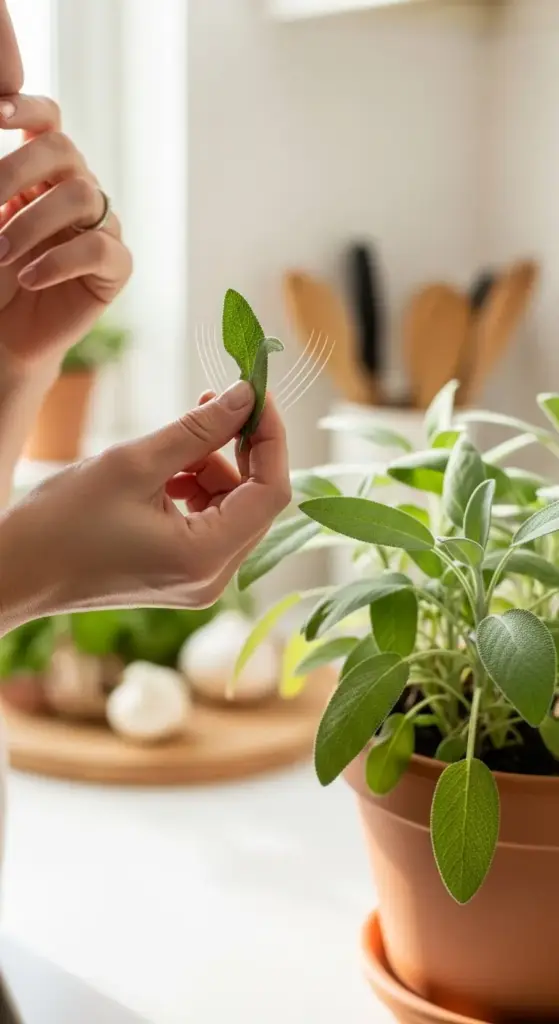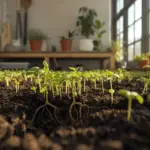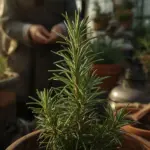Warning Sign #7: Loss of Aromatic Fragrance Signals Declining Plant Health

I almost missed this one completely. My sage looked okay – green leaves, decent growth, no obvious problems. But when I brushed against it while cooking, I realized something was off. Where was that amazing earthy smell?
What used to be an aromatic powerhouse that filled my kitchen with fragrance had turned into basically a scentless green decoration. I didn’t know it at the time, but this was my sage’s way of waving a white flag.
What Healthy Sage Should Smell Like
Fresh sage should hit you with fragrance from three feet away on a warm day. When I rub a healthy leaf between my fingers, the smell is so strong it lingers on my hands for hours.
The scent should be complex and layered – earthy, slightly bitter, with hints of pine and lemon. If your sage smells weak, grassy, or like nothing at all, something’s wrong with its internal chemistry.
Seasonal variations are normal though. My sage smells strongest in late spring and early summer when it’s actively growing. Winter fragrance is naturally more subdued but should never disappear completely.
Morning fragrance is typically strongest because that’s when essential oil concentrations are highest in the leaves. I do my “smell tests” right after my morning coffee for the most accurate reading.
I learned that stressed plants redirect energy away from essential oil production to focus on basic survival. No fragrance equals a plant in crisis mode.
The Stress-Fragrance Connection
Essential oils are basically the plant’s luxury items – when times get tough, they’re the first thing to go. My sage was putting all its energy into just staying alive instead of producing those aromatic compounds.
Multiple stressors compound the problem. When my sage was dealing with poor drainage AND low light AND irregular watering, the fragrance disappeared within two weeks.
Nutrient deficiencies particularly affect oil production. I discovered this when my sage’s smell returned after I started using a balanced liquid fertilizer every two weeks during growing season.
Root problems were the biggest fragrance killer in my experience. Even when the leaves looked fine, damaged roots couldn’t deliver the nutrients needed for essential oil synthesis.
Temperature stress also plays a role – extreme heat or cold drafts shut down oil production as the plant focuses on temperature regulation instead.
Reviving Your Sage’s Signature Scent
Proper fertilization brought my sage’s fragrance back faster than anything else. I use a balanced 10-10-10 liquid fertilizer diluted to half strength every two weeks during spring and summer.
Stress reduction was key – I fixed the drainage issues, moved it to better light, and established a consistent watering schedule. Within a month, the fragrance started returning.
Pinching flowers as soon as they appear redirects energy back into leaf and oil production. I learned this from an old Italian neighbor who grew the most fragrant herbs I’d ever smelled.
Morning harvesting encourages the plant to produce more aromatic compounds. I pick a few leaves every few days, always in the morning when oils are most concentrated.
I also started gentle leaf massage – literally rubbing the leaves between my fingers daily to stimulate oil production. Sounds weird, but it works.
The Pinch Test for Plant Vitality
The pinch test became my go-to diagnostic tool. I gently pinch a mature leaf and immediately smell my fingers – healthy sage should leave a strong scent that lasts several minutes.
Weak or no scent means the plant is stressed, even if it looks fine visually. This test caught problems weeks before I could see physical symptoms.
Leaf texture during the pinch test also tells a story. Healthy sage leaves feel slightly fuzzy and release oils easily. Stressed leaves feel papery or slick and don’t release much fragrance.
I do this test on different parts of the plant because stress often affects sections differently. The top growth might smell fine while lower leaves have lost their potency.
Seasonal baseline testing helps you understand your plant’s normal fragrance patterns. I keep notes about how strong the scent should be during different times of year.
Smart Harvesting for Continued Growth
Regular harvesting actually increases fragrance production by encouraging new growth. I learned to harvest frequently but never take more than one-third of the plant at once.
Cut just above leaf nodes where you can see tiny bumps on the stem. New branches will grow from these points, creating a bushier, more aromatic plant.
Morning harvesting between 8-10 AM gives you the most flavorful leaves and encourages the plant to produce more oils throughout the day.
I rotate my harvesting spots around the plant instead of always cutting from the same area. This prevents any section from becoming stressed or depleted.
Pinch, don’t cut for small harvests. Using your fingernails to pinch off individual leaves actually stimulates oil production better than clean cuts with scissors.
Recovery Timeline and Expectations
Week 1-2 after addressing stress factors, I noticed the first hints of returning fragrance. It wasn’t strong yet, but definitely detectable during the pinch test.
Month 1 brought noticeable improvement – the sage started smelling like sage again, though not at full strength. New growth was particularly aromatic.
Full fragrance recovery took about 6-8 weeks of consistent proper care. By month 2, my sage was more aromatic than it had ever been, probably because I’d finally learned how to care for it properly.
Patience is crucial during recovery. I made the mistake of over-fertilizing to speed things up, which actually set back the process by stressing the plant further.
The new growth that emerged during recovery was incredibly fragrant – sometimes stronger than the original plant. This taught me that proper care doesn’t just restore health, it can actually improve it.
Long-Term Fragrance Maintenance
Consistent care is the only way to maintain strong fragrance long-term. I created a simple routine: weekly pinch tests, bi-weekly fertilizing during growing season, and daily harvesting of a few leaves.
Environmental stability matters more than perfect conditions. My sage’s fragrance stays strong as long as I avoid dramatic changes in watering, light, or temperature.
Annual repotting with fresh, well-draining soil keeps the root system healthy and oil production high. I do this every spring when new growth starts appearing.
I also learned that companion planting can boost fragrance. My sage smells stronger when grown near other aromatic herbs like rosemary and thyme – they seem to encourage each other’s oil production.
Conclusion
Your indoor sage doesn’t have to become another casualty of well-intentioned plant parenting!
By catching these seven warning signs early—especially before that critical three-week mark—you can transform your struggling herb into a thriving, aromatic addition to your home.
Remember, successful indoor gardening isn’t about having a green thumb; it’s about being observant and responsive to your plants’ needs.
Start implementing these monitoring techniques today, and you’ll not only save your current sage but also develop the confidence to expand your indoor herb garden.
Your future self (and your dinner guests) will thank you when you’re snipping fresh, fragrant sage leaves for that perfect autumn recipe!









GIPHY App Key not set. Please check settings